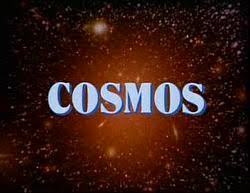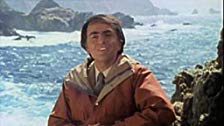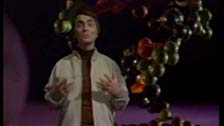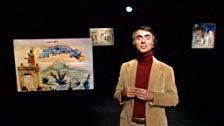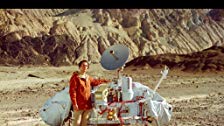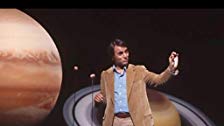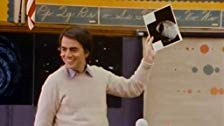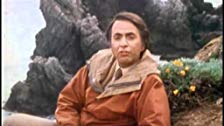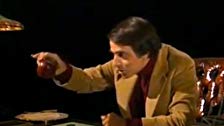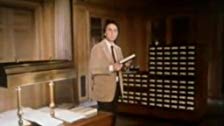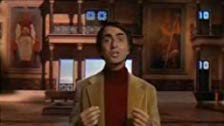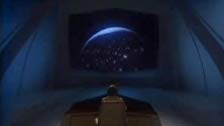Cosmos 1980: Difference between revisions
| Line 52: | Line 52: | ||
</br> | </br> | ||
== Episode 8 Journeys in Space and Time [[Image:3-stars.png|100px]] == | == Episode 8 Journeys in Space and Time [[Image:3.5-stars.png|100px]] == | ||
[[Image:Cosmos1980_e8.jpg|left]] An | [[Image:Cosmos1980_e8.jpg|left]] An pretty good episode. It starts with Carl explaining that everything in the universe is moving, and then showing is how the stars in the constellations are all moving and changing over time. He then explains the speed of light, and how what we see is inevitably something that happened in the past, and often quite some time ago due to the vast distances. | ||
</br> | </br> | ||
Revision as of 23:02, 22 March 2019
As I mentioned on the main The Great Courses page, I like this very much, and would recommend it as a good introduction to the history of astronomy and of the history of the universe.
Comos (1980) - Carl Sagan
This is the general description of the course/series. It's pretty bald for the ground they covered (anti-nuke preaching aside).
Astronomer Carl Sagan leads us on an engaging guided tour of the various elements and cosmological theories of the universe.
Episode 1 The Shores of the Cosmic Ocean 
Carl introduces us to “the ship of the imagination” that will take us on our tour of the universe. He also introduces us to the idea eloquently to the big questions of astronomy. He takes on a brief tour from the middle of the universe back to planet Earth, showing some of the major features of space. He then explains how, Eratosthenes (the chief librarian of Alexandria) derived the circumference of the Earth by a chance reading of the account of the lack of shadows in Syene on the equinox (June 21). He checked this against his observations in Alexandria, which had a shadow, and used the length of the shadow, the distance between the two cities, and calculated the circumference of the globe. He then takes us on a virtual tour of that library, and describes it’s loss before taking us to Kepler and the start of the scientific method, and the understanding of the Heliocentric solar system. Finally he introduces the Universe’s calendar, starting at the Big Bang, up until present time, where the last few minutes of the last day represent the entirety of human history. Good stuff.
Carl Sagan examines our planet's place in the universe by leading us on a journey from Earth to Deep Space.
Episode 2 One Voice in the Cosmic Fugue 
A pretty good episode that describes the building blocks of life, evolution (including a cool Japanese crab, the Heikegani) that has been preferentially saved because it looks like it has a Samurai face in its shell, to experiments at Cornell with the basic gases of the early Earth and how, with electricity, it forms proteins and nucleic acids and the building blocks of life. He closes with a virtual tour of Jupiter’s gases.
Carl Sagan examines the origin, development, and complexity of life on Earth and speculates on the possibility of life developing elsewhere in the universe.
Episode 3 Harmony of the Worlds 
This episode that places the start of the true scientific method, when your preconceived notions are set aside when the evidence doesn’t match. He also discusses the origin of the constellations, and their connection to astrology, and the notice of how regular they are/were - except the planets, the “wanderers”. He then visits the Anasazi and Stonehenge to describe the importance of the stars to early man and to time planting and the harvest. We then move on to Copernicus and the Heliocentric solar system and the explanation of retrograde motion of planets, describing the true motion of the planets. He then describes how Kepler discovered planets follow ellipses with the Sun at one focus - through the use of Tyco Brahe’s outstanding observations, and that the square of the orbital period is proportional to the third power of the radius of it’s orbit.
After briefly looking at the pseudoscience of astrology, Carl Sagan examines the history of astronomy from ancient times through Ptolemy to Johannes Kepler.
Episode 4 Heaven and Hell 
This episode is very good, describing the Tunguska comet event, who’s blast leveled a forest in Russia - without leaving a crater. He then describes Halley’s discovery of the return of the comet named for him - and the superstitions surrounding them with early man. He then relates the excellent story of English (Canterbury) monks seeing, and recording an asteroid strike on the moon, which we can now determine created (Giordano Bruno) crater on the north eastern side of the moon. Finally he describes how difficult it was to take any obersvations of Venus, and introducing absorption spectroscopy - before warning of (ahem) Global Warming.
Carl Sagan examines the nature of comets before turning to a close look at the planet Venus.
Episode 5 Blues for a Red Planet 
A pretty good episode that starts out by describing the War of the Worlds, and the many beliefs people used to hold about Mars. It goes on to chronicle the background and dreams of Robert H. Goddard. Sagan then shows us the Mars survey images of the day, including Olympus Mons and Mariner Valley, and a recap of the images and data from the Viking landers from the late 1970’s.
Carl Sagan looks at the search for life on Mars from the speculations of Percival Lowell and H.G. Wells to the arrival of the Viking probes.
Episode 6 Travellers' Tales
A pretty good show, starting at JPL with the Voyager flight, on the Jupiter fly-bys. It then wanders through the Dutch enlightenment and global exploration, and on to Galileo and timekeeping technology and the quest for longitude. He then introduces us to Christiaan Huygens, and his telescope construction techniques and discoveries. We then learn that Jupiter is a “failed star”, mostly Hydrogen, but just not (a few dozen times too small) big enough to cause nuclear fusion.
Carl Sagan looks at the planets Jupiter and Saturn by examining the work of Galileo, Huygens, and the Voyager probes.
Episode 7 The Backbone of Night 
A OK episode that starts with a bit of Sagan’s hometown of Bensonhurst, NY and a story from his biography about getting an astronomy book about stars. He then recounts the many historical views man had in ancient times about the meaning of the Milky Way in the night sky. We then move to the Greeks like Anaximander and Democritus, and their moves towards science. Sagan then spends a little too much time for my taste explaining the galaxy to a class of what look to be 5th or 6th graders in Brooklyn.
Carl Sagan looks at the work of ancient Greek scientists and astronomers including Thales, Anaximander, Democritus, and Pythagoras.
Episode 8 Journeys in Space and Time 
An pretty good episode. It starts with Carl explaining that everything in the universe is moving, and then showing is how the stars in the constellations are all moving and changing over time. He then explains the speed of light, and how what we see is inevitably something that happened in the past, and often quite some time ago due to the vast distances.
Carl Sagan explains scientific concepts like relativity and examines the possibility of time travel.
Episode 9 The Lives of the Stars 
Another pretty good episode, partly just because I appreciate it that not all men of science immediately discount anything of faith or in the Bible. Much like in Cosmos, there are excellent descriptions of the faithful aiding our understanding of the stars.
Carl Sagan examines the life cycle of stars from their creation to their deaths.
Episode 10 The Edge of Forever 
Pretty good, but constellation history is covered everywhere, so a lot of this wasn't really new to me.
Carl Sagan focuses on the origin of the universe by discussing the Big Bang, Galaxies, Dimensions, and the expansion of the universe.
Episode 11 The Persistence of Memory 
Pretty good, but again, like Episode 10, much of this is covered elsewhere so it feels less valuable, though it's exclusion would also seem strange. Worth watching.
Carl Sagan examines life on earth discussing genes, DNA, the brain, and human social development.
Episode 12 Encyclopaedia Galactica 
Astrology. What more is there to say? It is historically important, and it's interesting that they don't deal with precession, but otherwise? Meh.
Carl Sagan examines the possibility extraterrestrial life and discusses his skepticism about UFOs.
Episode 13 Who Speaks for Earth? 
Carl Sagan considers the significance of science and discuss the importance of human survival in the nuclear age.
